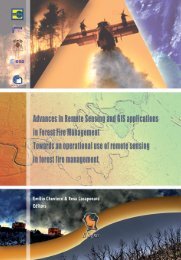Classification of the vegetation in the Virunga National Park (D.R. ...
Classification of the vegetation in the Virunga National Park (D.R. ...
Classification of the vegetation in the Virunga National Park (D.R. ...
Create successful ePaper yourself
Turn your PDF publications into a flip-book with our unique Google optimized e-Paper software.
Figure 1. Situation <strong>of</strong> <strong>Virunga</strong> NP and Volcanoes NP<br />
<strong>Virunga</strong> <strong>National</strong> <strong>Park</strong> was founded <strong>in</strong> 1925 by <strong>the</strong> Belgian Colonists. The park was primarily set<br />
up for scientific research, which is very exceptional <strong>in</strong> Africa. In addition to scientific research, <strong>the</strong><br />
aim was also to protect <strong>the</strong> mounta<strong>in</strong> gorilla and <strong>the</strong> hippopotamus. In <strong>the</strong> fifties, <strong>the</strong> decision <strong>of</strong> an<br />
<strong>in</strong>tegral conservation policy was taken. Because <strong>of</strong> its outstand<strong>in</strong>g conservation value, <strong>the</strong> park became<br />
a World Heritage Site <strong>in</strong> 1979. Fifteen years later, <strong>the</strong> World Heritage Committee decided to<br />
add <strong>the</strong> site to <strong>the</strong> List <strong>of</strong> World Heritage Sites <strong>in</strong> Danger. This decision was taken because <strong>the</strong>re<br />
were (are) several threats to <strong>the</strong> park. The crisis that has gripped <strong>the</strong> Great Lakes’ Region <strong>in</strong> Africa<br />
for over ten years also had a big impact on <strong>the</strong> region’s fauna and flora. The economy was <strong>in</strong> a<br />
desolate state and people became very poor. That is why some tried to survive by poach<strong>in</strong>g and unsusta<strong>in</strong>ably<br />
harvest<strong>in</strong>g. Between 1994 and 1996, Rwandan refugees came to Congo and were settled<br />
<strong>in</strong> and around <strong>the</strong> park. This <strong>in</strong>flux had a very negative impact on <strong>the</strong> biodiversity <strong>of</strong> <strong>the</strong> park.<br />
Supplementary all parks guards were disarmed <strong>in</strong> 1996 due to lack <strong>of</strong> f<strong>in</strong>ances. Tourism ceased<br />
completely <strong>in</strong> <strong>the</strong> same year, but is nowadays fortunately start<strong>in</strong>g aga<strong>in</strong>, which implies an important<br />
source <strong>of</strong> <strong>in</strong>come for <strong>the</strong> park. Today only about 670 mounta<strong>in</strong> gorillas are left.<br />
The aim <strong>of</strong> this study is to create a <strong>vegetation</strong> map <strong>of</strong> <strong>Virunga</strong> <strong>National</strong> <strong>Park</strong> (<strong>in</strong>clusive Volcanoes<br />
<strong>National</strong> <strong>Park</strong>) by us<strong>in</strong>g remote sens<strong>in</strong>g and <strong>in</strong>tegrat<strong>in</strong>g past mission reports, <strong>in</strong> order to be<br />
able to assist <strong>in</strong> managements and monitor<strong>in</strong>g activities <strong>of</strong> <strong>the</strong> sites.<br />
2 STUDY AREA, SENSOR AND DATA SOURCES<br />
2.1 Study area<br />
The study area consists <strong>of</strong> <strong>the</strong> sou<strong>the</strong>rn part <strong>of</strong> <strong>Virunga</strong> <strong>National</strong> <strong>Park</strong> and Volcanoes <strong>National</strong> park,<br />
hereafter named respectively as <strong>the</strong> area <strong>of</strong> <strong>the</strong> Western volcanoes and <strong>the</strong> area <strong>of</strong> central and Eastern<br />
volcanoes. Both sites are volcanic regions with a mounta<strong>in</strong>ous character with lots <strong>of</strong> differences<br />
<strong>in</strong> altitude. The area <strong>of</strong> <strong>the</strong> Western volcanoes comprises two major active volcanoes, namely <strong>the</strong><br />
Nyamuragira and <strong>the</strong> Nyiragongo, <strong>the</strong> latter be<strong>in</strong>g one <strong>of</strong> <strong>the</strong> most active volcanoes <strong>in</strong> Africa. The<br />
12<br />
J. Verbeken, L. De Temmerman, R. Goossens, Ph. De Maeyer & J. Lavreau
















